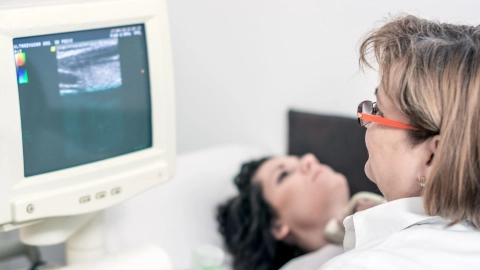Conditions Overactive thyroid
ICD codes: E05 What are ICD codes?
The thyroid gland regulates many body functions. When overactive, it produces too many hormones, imbalancing the metabolism. This can be treated in various ways.
At a glance
- The thyroid gland produces important hormones that regulate the metabolism.
- When overactive, the thyroid gland produces too many hormones, speeding up the metabolism.
- Typical symptoms include weight loss, nervous anxiety and heart palpitations.
- The most common cause of an overactive thyroid is Basedow’s disease, an autoimmune disease of the thyroid gland.
- There are various methods available for treating an overactive thyroid. In most cases, the excess hormone production is stemmed through the use of tablets.
Note: The information in this article cannot and should not replace a medical consultation and must not be used for self-diagnosis or treatment.

What is an overactive thyroid?
The thyroid gland is a hormone gland that regulates several bodily functions. If it is overactive it produces too many thyroid hormones. Such overactivity can have various causes. The most common of these is the thyroid condition known as Basedow’s disease.
If the volume of thyroid hormones in the blood is persistently higher than usual, many metabolic processes become imbalanced. This can result in a number of different symptoms, typically including weight loss, perspiration, nervousness or heart palpitations.
If left untreated, an overactive thyroid increases the risk of cardiovascular disease.
Video What are the common forms of thyroid disease?
This video explains what the most common forms of hypothyroidism and hyperthyroidism are, what causes them and how they are treated.
This and other videos can also be found on YouTube
Watch nowThe privacy policy indicated there applies.
What are the symptoms of an overactive thyroid?
In the case of an overactive thyroid, the thyroid gland often becomes enlarged and visible swelling appears on the neck. Doctors refer to this enlargement as a goiter (struma). In some cases, the only thing to form are palpable or visible nodules. It is also possible for neither a goiter nor nodules to form. Furthermore, an enlarged thyroid or thyroid nodule is not always associated with overactivity.
An overactive thyroid is often indicated by the following symptoms:
- heart palpitations and racing heartbeat, sometimes even cardiac arrhythmia
- high blood pressure
- weight loss despite feeling hungry more often
- diarrhea
- trembling, nervous anxiety, irritability, insomnia
- weakness, fatigue
- perspiration
People with an overactive thyroid also quickly find heat unpleasant. Their skin often feels warm and moist, and their hair starts to thin.
What causes an overactive thyroid?
The most common cause of an overactive thyroid is Basedow’s disease, an autoimmune disease of the thyroid gland. This is a condition where the immune system produces antibodies that stimulate the thyroid gland to produce excess hormones.
An overactive thyroid can also be caused when the thyroid gland starts functioning “autonomously”. The thyroid gland is usually controlled by the pituitary gland. When a thyroid gland starts functioning “autonomously”, the thyroid cells stop responding to the signals sent by the pituitary gland. This causes an excess production of thyroid gland hormones.
Autonomous thyroid cells sometimes occur throughout the entire gland and sometimes only in the tissue of one or more benign nodules. Such nodules are known as autonomous thyroid adenoma.
How common is an overactive thyroid?
An overactive thyroid is a common condition, affecting about one in every 100 people, usually between the age of 20 and 50.
What are the possible consequences of an overactive thyroid?
If not treated properly, an overactive thyroid may cause cardiovascular problems such as atrial fibrillation. In the long term, the accelerated bone remodeling process may also lead to osteoporosis.
How is an overactive thyroid diagnosed?
The first step in diagnosing an overactive thyroid is a detailed medical consultation. This is usually followed by a physical examination where the doctor feels the thyroid gland to see whether it is enlarged or if a nodule has perhaps formed. An ultrasound examination can be used to more precisely identify and assess changes to the thyroid tissue and existing nodules.
An examination of the eyes can also be useful. For example, bulging, swollen eyes can indicate a presence of Basedow’s disease – the most common cause of an overactive thyroid.
Blood tests also provide important information. They can be used to determine whether the thyroid itself is producing too many hormones or whether the overproduction is the result of the pituitary gland not properly controlling production. It is also possible to detect certain antibodies in the blood that can provide further indications of the presence of Basedow’s disease.
Another diagnostic method is scintigraphy, which can be used to detect the activity of a nodule. This is performed using weak radioactive substances, which are usually injected into a vein. The substances themselves emit rays that can be recorded using a special camera. This type of scintigraphy makes it possible to assess if a nodule is “hot”, i.e. producing excess hormones.
How is an overactive thyroid treated?
In mild cases, an overactive thyroid can sometimes go away of its own accord. In most cases, however, the excess hormone production by the thyroid gland has to be stopped using thyreostatics. These are a type of medication that inhibits the production of thyroid hormones.
Taking thyreostatics for a prolonged period can sometimes restore normal thyroid function in people with Basedow’s disease. If that does not work, the gland is removed surgically or radioactive iodine therapy is used. This involves doctors administering radioactive iodine in capsule form. The iodine is deposited in the thyroid gland and destroys the overactive cells.
If the thyroid gland is enlarged because it is operating autonomously, it is first “calmed down” with thyreostatics and then, in most cases, removed surgically. If surgery is not possible or the gland is not severely enlarged, radioactive iodine therapy is possible.
More detailed information on the treatment of an overactive thyroid can be found at gesundheitsinformation.de.
- De Leo S, Lee SY, Braverman LE. Hyperthyroidism. Lancet. 2016 Aug 27;388(10047):906-918. doi: 10.1016/S0140-6736(16)00278-6. Epub 2016 Mar 30. PMID: 27038492; PMCID: PMC5014602.
- Deutsche Gesellschaft für Allgemein- und Viszeralchirurgie e.V. (DGAV). Operative Therapie benigner Schilddrüsenerkrankungen. S2k-Leitlinie. AWMF-Registernummer 088-007. 12.2021.
- Deutsche Gesellschaft für Nuklearmedizin e.V. (DGN). Radioiodtherapie bei benignen Schilddrüsenerkrankungen. S1-Leitlinie. Version 5. AWMF-Registernummer 031-003. 10.2015.
- Jameson JL, Mandel SJ, Weetmann AP. Disorders of the Thyreoid Gland. In: D. L. Kaspers, S. L. Hauser, J. L. Jameson, Fauci AS, D. L. Longo, J. Loscalzo (Ed). Harrison's Principles of Internal Medicine. McGraw-Hill Education; 2015.
- Kahaly GJ, Bartalena L, Hegedüs L et al. 2018 European Thyroid Association Guideline for the Management of Graves’ Hyperthyroidism. Eur Thyroid J. 2018 Aug;7(4):167-186. doi:10.1159/000490384. Epub 2018 Jul 25. PMID: 30283735; PMCID: PMC6140607.
- Ross DS, Burch HB, Cooper DS et al. 2016 American Thyroid Association Guidelines for Diagnosis and Management of Hyperthyroidism and Other Causes of Thyrotoxicosis. Thyroid. 2016 Oct;26(10):1343-1421. doi: 10.1089/thy.2016.0229. Erratum in: Thyroid. 2017 Nov;27(11):1462. PMID: 27521067.
In cooperation with the Institute for Quality and Efficiency in Health Care (Institut für Qualität und Wirtschaftlichkeit im Gesundheitswesen – IQWiG).
As at:





